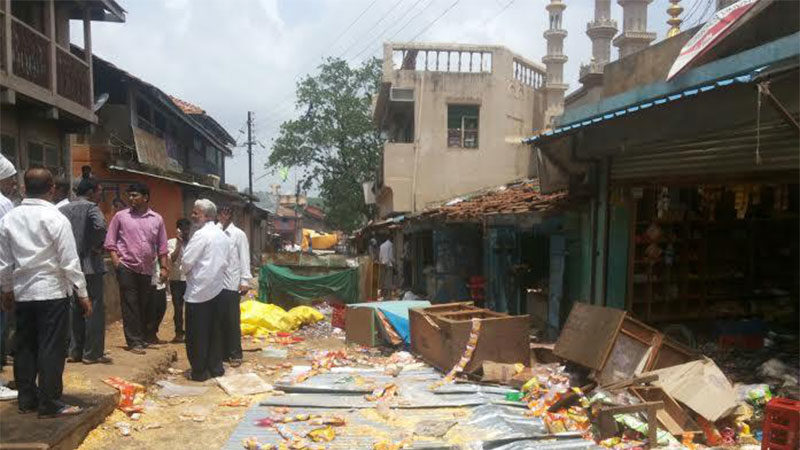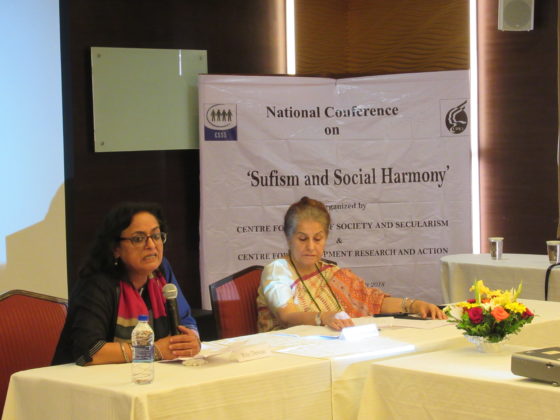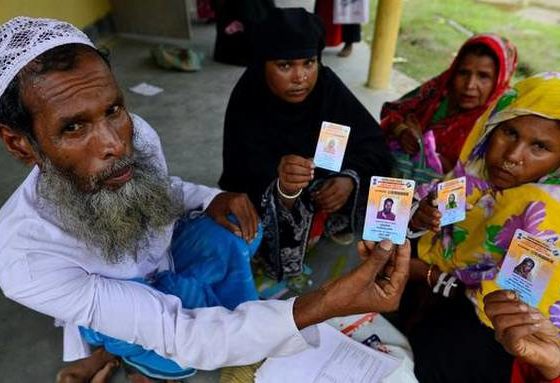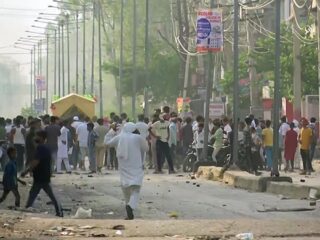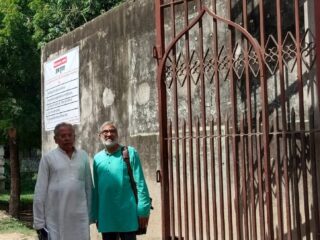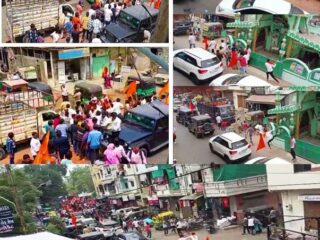Harsul is a town 50 kilometers away from Nashik in Maharashtra. It is also near Trimbakeshwar where the Kumbh Mela was organized this year. The town has a majority of population of Adivasis like Kokna, Warli, Chowdhary while other communities like Teli, Muslims and others also reside. The Adivasis are mostly marginal farmers, agricultural labourers and employed in shops owned by traders of other communities. The non Adivasis predominate in Harsul town but constitute a small part of the population. However they are powerful accruing to ownership of business and being traders including cloth and garment shops, shops for household utensils and agricultural tools and equipment. Harsul is trading centre for agricultural products like groundnuts. The town’s trading community is largely from Hindu-teli community and Muslims. Non-adivasis, including Muslims also own cultivable lands.
In Bhondermal village, in Harsul town, a body of a youth named Bhagirath Chowdhary, a kokna adivasi was found in a well of Rizwan Shaikh, having his land adjacent to that of Chowdhary. Bhagirath was 20 years old and awaiting his D.Ed results. The adivasis were outraged with this death and consequent refusal by police to register FIR for alleged murder of Bhagirath. It was reported in newspapers that the agitated Adivasi community in Harsul gathered together and set fire to approximately 20 shops owned by Muslims. This caused many Muslims to flee to Nashik out of fear to their lives and property. The social activists, civil society organizations and other concerned individuals took note of the incident and organized a fact finding mission in Harsul. The team visited Harsul on 25th July, 2015.
Fact Finding team:
The fact finding team consisted of members of the Centre for Study of Society and Secularism, Mumbai and the Pragatik Vichar Manch, Vani. The members consisted of teachers, researchers and social activists. The team was diverse in terms of its composition-age, religion and caste. The profile of the team was interesting and diverse.
- Adv.Irfan Engineer- Director of the Centre for Study of Society and Secularism, Mumbai and prominent activist- writer
- Dr. Sandhya Mhatre- Researcher at the Mumbai University, member of CSSS and activist
- Neha Dabhade- works with CSSS, Mumbai
- Mithulal Raka- associated with Pragatik Vichar Manch and activist
- Bhushan Deshmukh- social activist
- Ganesh Khare- a teacher at English medium school
- Jitendra Shirshat- staff at telephone exchange
- Anil Gangurde- self employed at his own laundry
(Ganesh, Jitendra and Anil are part of Dishantar Social group)
The fact finding team met with Bhagirath’s family in Bhondarmal village. The team then visited the market and interacted with Hindu shopkeepers. The team met a Muslim household who owned a shop in the village and one of the family members was a part of the Shiv Sena party. The team to gain greater insights into the death of Bhagirath, the violence which destroyed the property of the Muslims and investigation into the same, met the police in Harsul. Mr. Salunkhe is the Inspector of Police in charge of this case. The team met him too. To understand the overall politics and positions of different stakeholders, the team held a discussion with a journalist.
Findings of the team:
In order to comprehensively understand the conflict that took place in Harsul and its ramifications, it is necessary to locate the dispossessment and discrimination against the Adivasis in a wider framework. Adivasis are a marginalized population in the country. They have a distinct culture and follow their own different lifestyle. They also are deprived in terms of facilities like education, health and livelihood. Though there is a sizeable number of Adivasis in the town of Harsul, they stand as a vulnerable community owing to their place in social and economic hierarchy in the society. Majority of the Adivasis in the town are marginal agricultural laborers or small land holders. Its common to find them work at the shops owned by members of other communities. The farming and consequent production only ensures grains for approximately six months as told to the team by Bhagirath’s grandmother. This indicates towards the food insecurity. As explained by his uncle, most of the times, the Adivasis have to take loans from others to make ends meet. In such situation of indebtedness they work on their farms or shops for nominal wages in exchange. All these factors have led to economic exclusion of the Adivasis. This has serious implications on their social status as well as rights enjoyed as citizenship.
As narrated to the fact finding team by the different family members of Bhagirathi’s family, the State doesn’t recognize and enforce the rights of the Adivasis. Their pleas and grievances fall on deaf ears when they approach the State machinery for security and justice. Cited by the Chowdhary family and confirmed by a journalist, in the past few years, around seven murders of Adivasis have taken place in Harsul town. The police they allege haven’t carried out proper investigation which resulted in no justice or convictions. This has led to a perception that the police is insensitive towards the lives of the Adivasis and thus the Adivasis can’t rely on the police for protection or justice. To further fuel this belief, the police’s blatant refusal to file an FIR and carry out investigation as per procedural law laid down has disillusioned the Adivasis and enraged them.
The Chowdhary family from Bhondermal village owns land adjacent to one Rizwan Shaikh, the accused in Bhaghirath’s murder case. The two neighbouring families have been sharing cordial relationships since decades. This is reflected in the fact that the Chowdhary family had also lent money to the Shaikh family. There was also transaction related to land. Some land belonging to the Shaikh family was bought over by the Chowdhary’s. There was some persisting conflict between the families over the boundary of their farms but they were settling it peacefully. There was no fight or violence before this incidence. The Adivasis like the Chowdhary family doesn’t perceive the Muslims with animosity due to their religion. They share business and social relations since many years.
The incidence as narrated to the team by Bhagirath’s father Devidas and uncle is as follows. On the evening of 7th July, Bhagirath and his grandfather took the cattle for grazing. He went up to Rizwan Shaikh’s farms. Bhagirath’s uncle and father alleged that Rizwan Shaikh was in the state of inebriation and was abusive in his language. Listening to that Bhagirath’s grandfather decide to return back home and asked Bhagirath to do the same. However, even when Bhagirath didn’t return by 7pm, the family members went looking for him. Bhagirath’s father and uncle along with villagers went till the farm of Rizwan Shaikh and asked his servant if he had seen Bhagirath. The servant said he had come to the farm earlier in the evening but he hasn’t seen him again since then. However the relatives continued to look for Bhaghirath. The family alleges, when they reached the well in Rizwan Shaikh’s farm, they spotted a chappal (footwear) belonging to Bhagirath floating in the water. This deepened the anxiety and suspicion of the relatives. They called some swimmers from the village and requested them to go down in the well to see if they can find Bhagirath. After looking for some time, one swimmer came up with Bhagirath’s body.
The crucial aspect in this conflict and investigation into Bhagirath’s death is the role played by the police. The uncooperative and indifferent behavior of the police added to the angst of the family. They narrated that the relatives went to the Harsul police station on 7th July night itself to ask the police to come to the well to do the panchnama and take Bhagirath’s body for post mortem and further investigation. The police refused to go to the well and bring the body. They cited reasons like paucity of vehicles and officers to come all the way to the village. They asked the Chowdharies to get the body to the police station. Thus the Chowdhary family got Bhagirath’s body in a private vehicle to the hospital so that post mortem could be performed. When the father appealed to the Medical officer performing the post mortem to give an objective report, the officer refused to carry out the post mortem. They were finally persuaded to carry out the post mortem after the Chowdharies placed their trust in them in writing. When the body of Bhagirath was brought up his ear, nose and mouth were bleeding and his neck was swollen. All this indicated at an unnatural death caused not due to drowning according to the family. While the officers at the morgue were not cooperating, the police on the other hand also did not register an FIR on 7th or 8th July. The police never visited the residence of the Chowdhary for at least a week after this incidence. However later police filed an FIR on 17th July and arrested Rizwan Shaikh. The copy of the FIR that the fact finding team was privy to revealed that the police has falsely written 17th July as the date when they first got information of the crime. The Chowdhary family as they told the fact finding team had informed the police about Bhagirath’s body on 7th July itself. The FIR copy mentions no caste in front of the religion. The mention of the caste is left out and thus doesnt attract the sections of the SC/ST Atrocities Act which could stringently punish also the police for their lack of action. The fact finding team didn’t get a copy of the post mortem report but the earlier the police dismissed the incidence as drowning.
While this is one aspect where the police didn’t act for justice, other is their failure in protecting the Muslim community. The police was in the know how that the protest was organized and pamphlets regarding the same. There was a complete intelligence failure to apprehend the attackers and the forces planning them. The Muslims out of fear chose to leave the village and take rescue in Nashik. But the police did little to instill confidence or reach the root of the attack. The sections that are invoked in the FIR by the police are—–. The arrests so far—–
On 14th July, a condolence meeting was called by the Adivasi community in Harsul. Police fired on the mob and one person died in the firing. The mob then turned violent and attacked and looted over 20 shops belonging to the Muslims in the village. Many Muslims were injured and their shops looted of all valuables. While Muslims were at the receiving end of the mob, one adivasis youth lost his life when the police fired at him. This angered the mob and they retaliated by attacking the police. Over 49 policemen were injured on the first day of violence. In total 70 policemen were injured. As of 25th July, no panchnama was made regarding the looting and attacks on Muslims and the State has surveyed for damages causes. Thus no compensation is given for the loss. But the police gave an estimate of damage cause to be over one crore. But the police admitted that no survey of the damage was conducted. Some shopkeepers allege that that while on the first day the adivasis from the village were involved in the looting, the rest of the two days that followed saw the involvement of people outside of the village. But none were forthcoming to share who the attackers were.
However there are still questions unanswered. Its not clear yet as to how Bhagirath died. Since there is no panchanama, there is no authentic record which gives a clear picture as to how and where his body was found. Though the Chowdhary family suspects Rizwan Shaikh, there is no clear motive emerging from the investigation or against the cordial relations the two families that can explain why Rizwan Shaikh could have killed Bhagirath. While the judiciary would be the best judge of crime if it’s indeed committed and bring to justice the guilty, it is unfathomable as to how this conflict led to the whole Muslim community being attacked and their shops being looted. Its unclear as to who organized the mob or instigated it to attack. The Chowdhary family and the journalist vehemently made a case for the partisan role of the police which they claim haven’t investigated or brought to justice the guilty behind deaths of seven adivasis whose bodies were found in a the last few years. It can be surmised that this inaction of the police has become a sore point for the discontent of the Adivasis. But how this feeling of discontent was tapped and people mobilized for this attack is hazy and disturbing. But the facts like distribution of pamphlets, some members of political parties having knowledge of the impending attacks and the sheer number and weapons involved indicate towards the planned way this attack took place and thus can’t be mistaken for a spontaneous attack. There might be some political force or efforts by non state actors who play a strong role in spreading hatred against other communities. It is also doubtful if the mob that attacked consisted of adivasis or some people out of the Harsul. There are conflicting responses to this question.
This conflict is predominantly where the Adivasis experience exclusion from other communities in the society. It was not based on hatred towards any community based on religion. But this incidence was manipulated by vested interests to stigmatize the Muslim community by repeating that Bhagirathi was murdered by Rizwan Shaikh (matter still subjudice) and pitting the Muslim and Adivasi community against each other. This strategy has vitiated the communal harmony of Harsul. Unfortunately this mobilization hasn’t challenged the marginalization faced by the Adivasis. Instead it has undermined the solidarity between communities.
Conclusion/ Analysis:
The Adivasis in Harsul like in other parts of the country face discrimination, exploitation and dispossession at the hands of the trader community. They work in the establishment of the traders for years and work on the farms of the other communities for small wages. Some Adivasi families who are engaged in agriculture manage to produce only enough grains that last them for six months. This system that treats them like a second class citizen and denies their human rights has led to built up discontent and feeling of injustice. However there is no feeling of animosity against the Muslim community due to their religion. The Adivasis perceive all the traders as exploiters.
In this particular conflict, the death of Bhagirath and the alleged involvement of Rizwan Shaikh was exploited and manipulated by the vested interests to attack the Muslim community in the village. Vested interests include political parties and non state actors- Hindu nationalist organizations. The role of the police which is found wanting in many aspects have compounded the conflict. One can’t help but cite the general trend of violence, displacement and targeting of the Muslim community adversely affecting them. This has instilled fear and a sense of helplessness in the community. The fear was so palpable that the community was not openly coming out with any names of those involved in the violence. The community feels that it is better if they don’t confront the perpetrators or pursue justice since they have to live in the midst of the same people. They also politically align with Shiv Sena which doesnt particularly have a record of upholding the rights of the Muslims. As informed by some Muslim members of the party, they were informed about the impending attack on the Muslim community. But Shiv Sena didn’t do anything to protect the community. Yet, the quest for security and peace leads Muslims to aligning with the powerful.
Recommendations of the team:
The fact finding team strongly feels that Bhagirath must get justice. His death has been usurped as an excuse by vested interests to wreck violence on the Muslim community. This doesn’t augur well for the tradition of peaceful coexistence of Harsul. Thus proper and fair investigation be carried out by the police to ensure that the guilty be brought to justice. The police and judiciary will have to help to determine if it was an accident or murder. Towards this, the first step would be to correct the FIR and mention the caste of Bhagirath so that stringent sections will be applicable in the case leading to higher probability of conviction. The criminal justice system must treat the adivisis with sensitivity, inclusiveness and fairness. At the same time the police must investigate into the organizations or individuals who have spread hatred or organized the mob and egged on this violence. From the widespread damage and other aspects discussed above, it appears that the attacks were planned. These elements mar the harmony and peace of the country and exacerbate enmity between different groups on grounds of religion which is punishable even under the Indian Penal Code. Three days of looting have dispossessed the Muslim traders who have suffered heavy losses. They must be compensated for their loss by the State. The survey for damage must be carried out at the soonest so that the process of granting compensation is expedited. Those involved in the looting must be arrested and tried.

